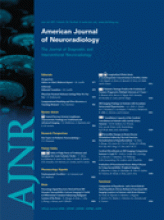LetterLetter
Predicting Transformation to Type 2 Parenchymal Hematoma in Acute Ischemic Stroke by CT Permeability Imaging
K. Lin
American Journal of Neuroradiology June 2011, 32 (6) E124; DOI: https://doi.org/10.3174/ajnr.A2602

References
- 1.↵
- Hom J,
- Dankbaar JW,
- Soares BP,
- et al
- 2.↵
- Larrue V,
- von Kummer RR,
- Muller A,
- et al
- 3.↵
- Berger C,
- Fiorelli M,
- Steiner T,
- et al
- 4.↵
- Wahlgren N,
- Ahmed N,
- Dávalos A,
- et al
- 5.↵
- Hacke W,
- Kaste M,
- Bluhmki E,
- et al
- 6.↵
- Lin K,
- Kazmi KS,
- Law M,
- et al
- 7.↵
- Bisdas S,
- Hartel M,
- Cheong LH,
- et al
- 8.↵
- Dankbaar JW,
- Hom J,
- Schneider T,
- et al
- 9.↵
- Aviv RI,
- d'Esterre CD,
- Murphy BD,
- et al
- 10.↵
- Schneider T,
- Hom J,
- Bredno J,
- et al
In this issue
Advertisement
K. Lin
Predicting Transformation to Type 2 Parenchymal Hematoma in Acute Ischemic Stroke by CT Permeability Imaging
American Journal of Neuroradiology Jun 2011, 32 (6) E124; DOI: 10.3174/ajnr.A2602
0 Responses
Jump to section
Related Articles
Cited By...
- No citing articles found.
This article has not yet been cited by articles in journals that are participating in Crossref Cited-by Linking.
More in this TOC Section
Similar Articles
Advertisement











